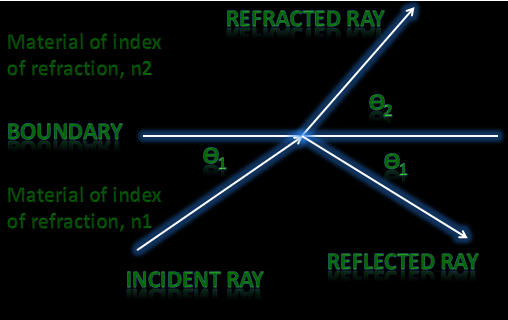MATERIALS:
1. A big tin can or a plastic pot (The pot must not be transparent or semi-transparent)
2. Some fresh water
3. A torch light
4. A dark room (Not necessarily the dark room for developing
films just a room with less light)
INSTRUCTIONS:
1. At first put some water in the tin can or pot. Fill it to the brim.
2. Now poke a small hole on the side of the can or
pot. Make the hole on the lower middle part of the pot.
3. After that open the top of the can and aim the
light of a torch light on the water.
4. Now observe what happens.
RESULT:
1. When you poke a hole on the side of the tin can or pot the water inside the pot starts to leak out with a certain amount of flow.
2. When you aim the torch light inside the tin can
you will see that the water which is leaking out is looking like a curved ray
of light.
EXPLANATION:
 |
| Reflected and refracted light at a boundary of differing index of refraction |
We know that light ray always travels in a straight path. But in this experiment it looks like that light ray is travelling in a curved path. How is that possible?! This is possible because of a law of physics which is called total internal reflection. The light of the torch which was aimed inside the tin can is trapped within the flow of the water because of the total internal reflection. And because of that light is also curved along with the curved water. Some low amount of light refracts outside the flow of the water which makes the water look something like liquid light!
MORE EXPLANATIONS:
When the light strikes the boundary between two transparent or semi-transparent materials of different indices of refraction, the path of the light ray is altered into two different ways. At first the light is reflected. So the light energy which is reflected does not enter the material at the other side of the boundary. The remaining light energy does not enter the material but the path of the light ray is altered.
[From – Modern Electronic instrumentation and Measurement Techniques, Fifth Indian Reprint, Chapter 14 – fiber Optics Measurements, Page – 419, Writers- Albert D. Helfrick and William D. Cooper]
MORE EXPERIMENTS FOR YOU:
1. Try the experiment both in hot and cold water.
2. Use vinegar instead of water.
3. Use oil instead of water.
4. Try adding soap in the water.
No comments:
Post a Comment